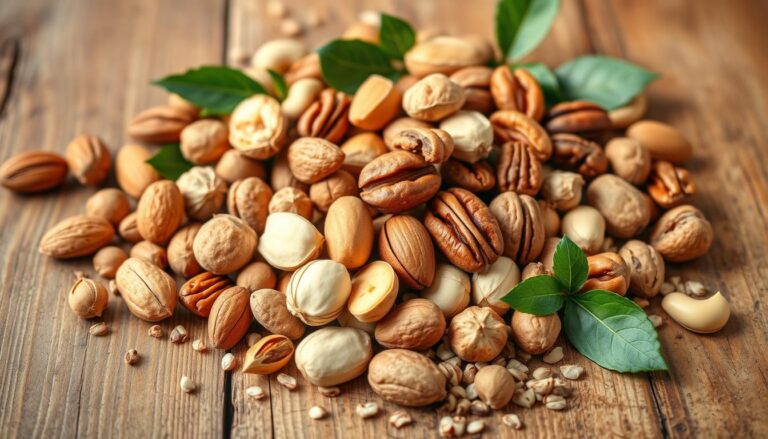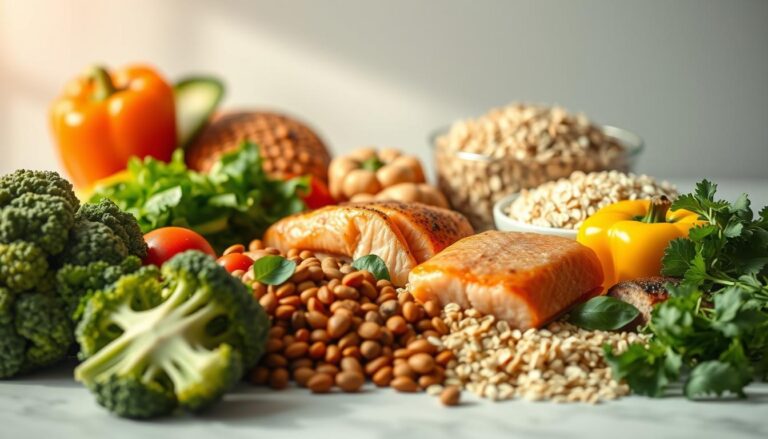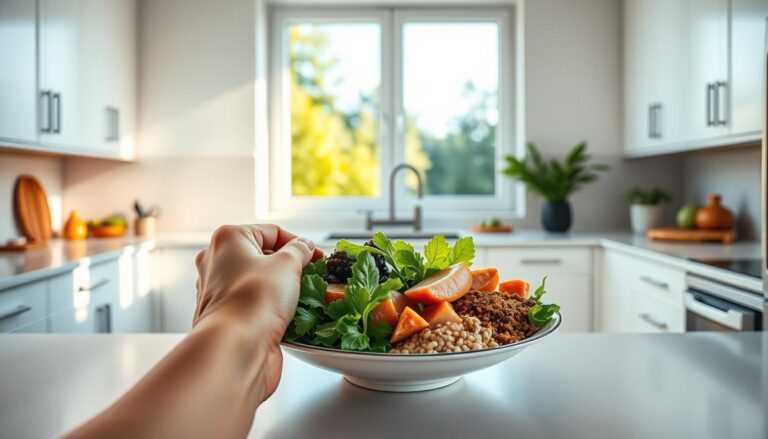Can you really lose 10 kg in 40 days with a effective weight loss plan and stay healthy? This article shares a science-backed plan that includes nutrition, exercise, and behavior changes. It’s designed to help you lose weight safely and effectively.
Health experts say losing weight safely means cutting 500–700 calories a day. This equals losing 0.5–1 kg each week. The NHS recommends a 12-week plan and tips like drinking water instead of sugary drinks to start.
Studies show drinking water before meals can cut calorie intake by 13%. Activities like walking errands also increase daily activity. This plan focuses on balanced meals, sleep, and tracking your progress.
By adding high-protein foods and fiber-rich options like avocados, you keep your energy up and lose fat. This way, you maintain muscle mass while shedding pounds.
Key Takeaways
- Follow a calorie deficit of 500–700 calories daily for safe, sustainable losing weight quickly and safely.
- Use NHS resources like exercise videos and meal plans to guide your journey.
- Incorporate 150 weekly minutes of activity, such as biking or squats.
- Track progress through photos and daily goals to stay motivated.
- Prioritize sleep and hydration to support metabolic health.
Understanding the 10 kg Weight Loss Challenge
Losing 10 kg in 40 days means finding a balance. You need to cut down on calories and eat healthy. This goal is about losing 0.5–1 kg each week, but you want to lose it faster.
This fast pace can be hard on your body. It might lead to not getting enough nutrients or losing muscle. You need the right guidance to avoid these problems.
Is Losing 10 kg in 40 Days Healthy?
Doctors say losing 0.5–1 kg a week is best for your health. But, you want to lose 2.5 kg a week to reach your goal. This is faster than what’s safe.
It can cause tiredness, problems with electrolytes, and you might gain weight back. How fast you can lose weight depends on your starting weight, how your body works, and your health history.
- Medical supervision is key to check for risks like heart problems or hormonal issues.
- It’s important to eat enough protein and fiber to keep your energy up.
- Keeping track of sleep and drinking water is also important to avoid eating too much because of stress.
While it’s possible for some, losing 10 kg in 40 days is tough. You must stick to counting calories and eating the right foods. Success depends on matching your plan to your health needs. Always talk to a dietitian or doctor before starting a fast weight loss plan to make sure it’s safe and works for you.
What is the Best Plan to Lose 10 kg in 40 Days?
A successful 40-day weight loss journey needs proven strategies for rapid weight loss. It’s important to focus on safety and sustainability. The best plan balances calories, nutrients, and exercise to lose 0.5-1 kg a week. This can lead to losing up to 11.42 kg in 40 days.
Begin by figuring out your daily calorie needs. Use tools like MayoClinic.com’s calculator. Men should aim for 1,500 calories, women for 1,200. Spread your meals out: 250 calories for breakfast, 300 for lunch, 250 for dinner, and 200 for snacks.
Make sure to eat lean proteins (40g/day), like chicken and fish. Also, eat 3-5 vegetable servings and whole grains.

“A calorie deficit without proper nutrient intake risks muscle loss and fatigue,” states the National Institute of Health. Effective plans integrate protein-rich meals and moderate exercise.
- Meal examples: Oatmeal for breakfast, brown rice with dal for lunch, grilled chicken salads at dinner
- Exercise protocol: 30 minutes daily cardio, strength training 3x/week, and yoga for flexibility
- Behavioral tactics: Hydrate with lukewarm water pre-meals, sleep 7+ hours nightly
Start your day with detox rituals like cumin water or cucumber-ginger blends. They help boost your metabolism. Use apps like MyFitnessPal to track your progress and adjust your portions weekly. Always talk to a doctor before starting any diet under 1,000 calories a day.
Calculating Your Caloric Needs for Effective Weight Loss
Figuring out how many calories you need is key to achieving weight loss goals. Your Basal Metabolic Rate (BMR) shows how many calories your body burns when you’re not moving. It’s the base for a healthy calorie deficit.
To find your BMR, use proven formulas that match your body:
- Mifflin-St Jeor (Most Accurate): Women: (10 × weight in kg) + (6.25 × height in cm) – (5 × age) – 161
- Men: (10 × weight in kg) + (6.25 × height in cm) – (5 × age) + 5
Then, add activity multipliers to your BMR to get your total daily energy expenditure (TDEE):
- Sedentary: ×1.2
- Moderately active: ×1.55
- Active: ×1.725
To lose 0.5–1kg a week, aim for a 500–700 calorie deficit each day. Losing too much can lead to not getting enough nutrients, which can hurt your successful weight loss journey. For instance, a 70kg woman with a BMR of 1,400 calories and moderate activity would need 2,170 calories a day. Cutting 500 calories brings that down to 1,670.
Try zigzag calorie cycling to avoid your body getting used to the same calorie intake. Keep track of your progress each week and adjust your calories if needed. Focus on steady, healthy weight loss to keep your muscle mass up.
The Optimal Nutrition Strategy for Rapid Results
To lose weight fast, you need a good plan for what you eat and when. A healthy diet plan for rapid weight loss should have the right mix of protein, carbs, and fats. This keeps you full and helps your body burn fat.
Eat foods that are full of nutrients like lean meats, leafy greens, and whole grains. This helps you keep your muscles while eating fewer calories. Aim to cut 500-750 calories from your daily diet.

“Whole foods and consistent hydration form the foundation of sustainable weight loss.”
Here are some key tips:
- Eat high-protein meals to feel full and control hunger.
- Choose low-glycemic carbs like quinoa and oats to keep insulin levels steady.
- Add foods rich in omega-3s, like avocados and walnuts, for hormone balance.
- Try intermittent fasting, like the 16/8 method, to burn more fat.
| Meal Type | Options | Calories |
|---|---|---|
| Breakfast | Idli sambar, oatmeal with fruits | 230–250 |
| Lunch | Brown rice with dal, chicken curry | 300 |
| Snacks | Green tea with rusk, nuts, fruits | 100–200 |
| Dinner | Vegetable wrap, chicken noodle soup | 250 |
Also, get 7 hours of sleep and manage stress to keep cortisol levels in check. Monitor your progress every week and adjust your portions if needed. Sticking to this plan can help you lose 0.5–1kg each week for 40 days.
Protein-Focused Meal Planning for Preserving Muscle Mass
Keeping muscle mass up is key when you’re trying to lose weight fast. You need enough protein to stop your muscles from breaking down. This helps you lose weight safely and keep your metabolism and strength up.
Studies show that eating enough protein helps keep lean tissue when you’re cutting calories. This is important for your health and fitness.
“Protein synthesis requires consistent intake to counteract muscle catabolism during dieting,” notes clinical nutrition studies.
The Importance of Protein During Weight Loss
- Incorporate 1.6–2.2g protein per kg body weight daily.
- Choose complete protein sources like eggs, fish, poultry, and legumes.
- Time protein intake evenly across meals for anabolic effects.
| Meal | Components |
|---|---|
| Breakfast | 6 egg whites + 100g oats |
| Lunch | 60g cottage cheese + 80g broccoli |
| Snack | 8 egg whites + 30g avocado |
| Dinner | 50g broccoli + 100g blueberries + 50g tofu |
| Pre-sleep | 10 egg whites + 50g asparagus |
Eating protein-rich meals like Cranberry Roast Chicken & Potato Bake and Korean BBQ Beef Noodles is good. They help you get enough protein. Use bio-impedance scales to check your muscle mass.
Don’t cut carbs too much, except before working out. This helps keep your glycogen stores up. Choose lean proteins to feel full and burn fat better.
Use low-calorie proteins like egg whites and tofu to control hunger. Make sure you’re getting enough protein to avoid losing muscle. Eating protein at regular times helps your muscles and burns fat.
Strategic Carbohydrate Management for Faster Fat Loss
Effective proven strategies for rapid weight loss focus on managing carbs. This helps burn fat without losing energy. Carb cycling, which alternates between high, moderate, and low-carb days, boosts fat loss. It fits well with a successful weight loss journey by matching food intake with activity levels.

- High-carb days (200–400g): Eaten on training days to refill glycogen and fuel workouts.
- Moderate-carb days (100g): Used on light activity days to keep energy balanced.
- Low-carb days (30g): Saved for rest days to boost fat burning.
Protein stays the same at 1.6–2.2g/kg body weight. Fat intake goes down when carbs do. For example, on low-carb days, healthy fats like avocados and nuts help keep you full. Research shows this method can lead to 2–3kg weight loss in the first week for those who are severely overweight. But, people with diabetes or heart issues should talk to their doctors before starting.
“Carb cycling avoids metabolic plateaus by preventing insulin resistance and maintaining muscle mass,” states the Journal of the American College of Nutrition. “This method supports sustained fat loss without extreme calorie deprivation.”
Watch how your body reacts to carbs by tracking energy and ketone levels (if using ketosis). Eat carbs around workouts to use them best. Sticking to this plan improves insulin sensitivity, a key for a successful weight loss journey.
Essential Exercise Components to Accelerate Your Weight Loss
Regular exercise is key to losing weight in a month. A mix of cardio and strength training is best. It boosts your metabolism and helps keep muscle mass. Try to work out at least 150 minutes a week, spread out to avoid getting tired.
- Brisk walking: Burns 170 calories in 30 minutes (8,000–10,000 daily steps ideal).
- HIIT: 272 calories in 30 minutes for a 150-lb individual.
- Strength training: 102 calories in 30 minutes but increases muscle mass long-term.
Combining Cardio and Strength Training
Polarized training is great for burning fat and keeping your metabolism healthy. Mix high-intensity workouts like sprinting or cycling with moderate activities like hiking or swimming. For example, do 20 minutes of HIIT twice a week and 3-4 days of strength training with big movements like squats and deadlifts.
Make exercise a part of your daily life. Take the stairs, walk while on calls, or do yoga in the morning. Choose exercises you like to keep up with them. Track your progress and adjust your workouts as needed. Remember to have rest days to keep your energy up.
Staying Hydrated: The Often Overlooked Weight Loss Catalyst

Drinking enough water is key for effective weight loss. It helps your body burn fat by improving how cells use energy. Even a little dehydration can slow down how fast you lose fat.
When hunger strikes, drink a glass of water and wait 30 minutes. Persistent hunger after two glasses signals true food needs.
- Metabolic Support: Water helps break down fat cells and moves nutrients to muscles when you exercise.
- Appetite Control: Drinking water stops you from eating too much by reducing false hunger signals.
- Blood Sugar Regulation: Staying hydrated keeps your blood sugar levels steady, reducing sugar cravings.
Follow the healthy diet plan for rapid weight loss hydration protocol:
- Drink 7 glasses daily (Triple Seven Rule)
- Start mornings with warm water + lemon/ginger for digestion
- Drink 2 cups of green tea a day for a metabolic boost
- Use diluted apple cider vinegar (1 tsp in water) to regulate blood sugar
Keeping your mitochondria healthy is all about staying hydrated. This helps you burn calories better. Adding these tips to your exercise routine will help you lose fat and keep your muscles. Drinking water also helps you feel less bloated and makes it easier to stick to your diet.
Sleep and Stress Management: Critical Factors in Your Success
Effective fast weight loss tips must address sleep and stress. Losing weight quickly and safely requires balancing these overlooked factors. Poor sleep disrupts hormones like ghrelin and leptin, driving hunger and impeding progress.
How Poor Sleep Sabotages Weight Loss
Research shows sleep deprivation below 6 hours increases waist circumference and hunger hormones. Sleeping less than 7 hours nightly raises ghrelin (hunger signals) and lowers leptin (satiety signals), leading to 200–500 extra calories consumed daily. Poor sleep also impairs insulin sensitivity, promoting fat storage.
- Target 7–9 hours of sleep nightly to stabilize hunger hormones.
- Avoid eating 2–3 hours before bed to improve sleep quality.
- Use blackout curtains or white noise machines to enhance sleep environments.
| Factor | Impact on Weight Loss | Action |
|---|---|---|
| Short Sleep | Increases ghrelin, lowers leptin → higher calorie intake | Consistent bedtime routine |
| Stress | Rises cortisol → fat storage and cravings | Yoga or meditation daily |
A study found that extending sleep by 1.8 hours reduced daily calorie intake by 270 kcal, aiding sustainable deficits.
Stress management is equally vital. Chronic stress elevates cortisol, a hormone that encourages visceral fat storage. Stress-induced emotional eating often leads to junk food choices, counteracting calorie deficits. Incorporate mindfulness practices to lower cortisol levels and maintain progress.
Combining 7–9 hours of sleep with stress reduction creates hormonal balance essential for losing weight quickly and safely. Prioritize these factors to support metabolic efficiency and fat loss during your 40-day plan.
Tracking Progress and Making Adjustments Throughout the 40 Days
Keeping track of your progress is essential for proven strategies for rapid weight loss. Regular monitoring helps you see what’s working and where you need to make changes. Follow these steps to stay on track:
- Record your daily food intake and weekly weight changes in a journal or app like MyFitnessPal.
- Measure your waist circumference and body fat percentage every two weeks to see if you’re losing fat or just water.
- Use activity trackers like Fitbit to keep an eye on your steps, heart rate, and exercise intensity.
- Recalculate your calorie needs every 10 days as you lose weight to avoid hitting a plateau.
- Adjust your portion sizes using visual guides (e.g., a fist = 1 cup of vegetables).
For a successful weight loss journey, be flexible. If you’re not losing weight as fast, try reducing your daily calories by 100-200 or increase your strength training. Don’t make extreme cuts that make you tired. Keep an eye on your energy levels and recovery to avoid burnout.
A consistent tracking system is the foundation of sustainable results. Small, frequent adjustments keep metabolism active and goals achievable.” — Dr. Emily Carter, Nutrition Scientist
Do weekly reviews to adjust your meal plans or exercise routines based on your progress. For example, if you’re hungry, try replacing one meal with a protein shake. Or, add interval training to your cardio sessions. The successful weight loss journey is about adapting strategies to how you respond, not sticking to a strict plan. Use SMART goals to set measurable targets, like reducing your waist circumference by 2cm in 20 days. Regular checks help keep the 10% calorie deficit effective without losing muscle or energy.
Overcoming Plateaus and Common Obstacles
Hitting a plateau is a common challenge when shedding pounds in a month. To keep moving forward, it’s important to tackle both metabolic and behavioral factors. Many people get stuck because their calorie needs drop or they feel mentally tired.
“The weight loss journey can be overwhelming for any dieter, specially beginners. This program lets you get support from your loved ones. They can motivate you and even keep you on track with your actions.”
- Check your calorie intake every week to fight metabolic slowdown.
- Eat more protein, aiming for 25–35% of your daily calories to reduce cravings.
- Try intermittent fasting (like the 16/8 method) to change your eating habits.
| Obstacle | Solution | Action Steps |
|---|---|---|
| Metabolic slowdown | Reverse dieting | Raise calories by 10% for 3–5 days monthly |
| Cravings | High-fiber foods | Include 25–30g fiber daily via vegetables and legumes |
| Stress eating | Yoga or meditation | Practice 10-minute mindfulness sessions daily |
Being mentally strong is just as important. Having a support group and following meal plans can help a lot. Make sure to get enough sleep (7–9 hours) and cut down on refined carbs to avoid plateaus. Stick to these steps to keep moving towards your weight goal.
Conclusion: Transforming Your 40-Day Plan into Sustainable Habits
The 40-day period is a great start for making changes. But, lasting success comes from turning short-term plans into daily habits. An effective weight loss plan should fit into your daily life.
Building muscle through strength training can increase your metabolism. Eating nutrient-rich foods helps keep your metabolism healthy. Avoiding strict diets is key. Slowly increase your workouts and food intake to keep moving forward.
Using techniques like adding short workouts to your day helps stick to your plan. A successful weight loss journey focuses on your mindset, not quick fixes. Small habits, like planning meals and staying accountable, are the start of lasting change.
Real-life examples show that slow and steady wins. Focus on feeling good and confident, not just losing weight. This keeps you motivated for the long haul.





